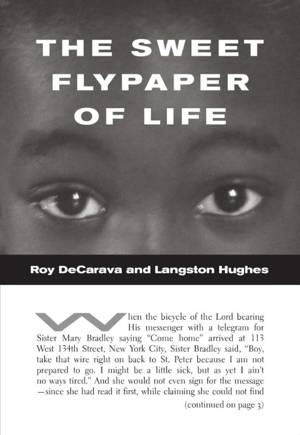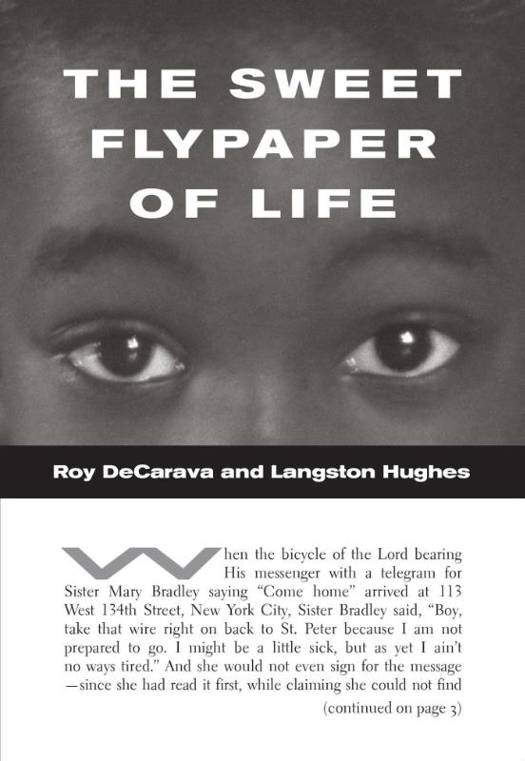
- Afhalen na 1 uur in een winkel met voorraad
- Gratis thuislevering in België vanaf € 30
- Ruim aanbod met 7 miljoen producten
- Afhalen na 1 uur in een winkel met voorraad
- Gratis thuislevering in België vanaf € 30
- Ruim aanbod met 7 miljoen producten
Zoeken
Omschrijving
The Sweet Flypaper of Life is a “poem” about ordinary people, about teenagers around a jukebox, about children at an open fire hydrant, about riding the subway alone at night, about picket lines and artist work spaces. This renowned, life-affirming collaboration between artist Roy DeCarava and writer Langston Hughes honors in words and pictures what the authors saw, knew, and felt deeply about life in their city.
Hughes’s heart-warming description of Harlem in the late 1940s and early 1950s is seen through the eyes of one grandmother, Sister Mary Bradley. We experience the sights and sounds of Harlem as seen through her learned and worldly eyes, expressed here through Hughes’s poetic prose. As she states, “I done got my feet caught in the sweet flypaper of life and I’ll be dogged if I want to get loose.” DeCarava’s photographs lay open a world of sense and feeling that begins with his perception and vision. The ruminations go beyond the limit of simple observation and contend with deeper meanings to reveal these individuals as subjects worthy of art. While Hughes states “We’ve had so many books about how bad life is, maybe it’s time to have one showing how good it is,” the photographs bring us back to this lively dialogue and a complex reality, to a resolution that stands with the optimism of the photographic medium and the certainty of DeCarava’s artistic moment.
In 1952 DeCarava became the first African American photographer to win a John Simon Guggenheim Memorial Fellowship. The grant enabled DeCarava to focus on the photography he had been creating since the mid-1940s and to complete The Sweet Flypaper of Life , a moving, photo-poetic work in the urban setting of Harlem. DeCarava compiled a set of images from which Hughes chose 141 and adeptly supplied a fictive narration, reflecting on life in that city-within-a-city. First published in 1955, the book, widely considered a classic of photographic visual literature, was reprinted by public demand several times. This fourth printing, the Heritage Edition, is the first authorized English-language edition since 1983 and includes an afterword by Sherry Turner DeCarava tracing the history and ongoing importance of this book.
Hughes’s heart-warming description of Harlem in the late 1940s and early 1950s is seen through the eyes of one grandmother, Sister Mary Bradley. We experience the sights and sounds of Harlem as seen through her learned and worldly eyes, expressed here through Hughes’s poetic prose. As she states, “I done got my feet caught in the sweet flypaper of life and I’ll be dogged if I want to get loose.” DeCarava’s photographs lay open a world of sense and feeling that begins with his perception and vision. The ruminations go beyond the limit of simple observation and contend with deeper meanings to reveal these individuals as subjects worthy of art. While Hughes states “We’ve had so many books about how bad life is, maybe it’s time to have one showing how good it is,” the photographs bring us back to this lively dialogue and a complex reality, to a resolution that stands with the optimism of the photographic medium and the certainty of DeCarava’s artistic moment.
In 1952 DeCarava became the first African American photographer to win a John Simon Guggenheim Memorial Fellowship. The grant enabled DeCarava to focus on the photography he had been creating since the mid-1940s and to complete The Sweet Flypaper of Life , a moving, photo-poetic work in the urban setting of Harlem. DeCarava compiled a set of images from which Hughes chose 141 and adeptly supplied a fictive narration, reflecting on life in that city-within-a-city. First published in 1955, the book, widely considered a classic of photographic visual literature, was reprinted by public demand several times. This fourth printing, the Heritage Edition, is the first authorized English-language edition since 1983 and includes an afterword by Sherry Turner DeCarava tracing the history and ongoing importance of this book.
Specificaties
Betrokkenen
- Auteur(s):
- Uitgeverij:
Inhoud
- Aantal bladzijden:
- 108
- Taal:
- Engels
Eigenschappen
- Productcode (EAN):
- 9780999843819
- Verschijningsdatum:
- 6/09/2018
- Uitvoering:
- Paperback
- Afmetingen:
- 107 mm x 183 mm
- Gewicht:
- 218 g

Alleen bij Standaard Boekhandel
+ 49 punten op je klantenkaart van Standaard Boekhandel
Beoordelingen
We publiceren alleen reviews die voldoen aan de voorwaarden voor reviews. Bekijk onze voorwaarden voor reviews.











